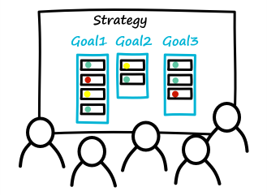
Kickstarting strategy implementation — 2.02
Markus Westerlund
Share this blog
Once the strategy is ready, how does the organization kickstart the strategy implementation?

I’m excited about the above strategy model! It’s simple, and it shows the journey clearly from a helicopter perspective.
Kickstarting strategy implementation: The Three Loops
In the first loop, the company’s direction becomes defined. Everyone receives an invite to join the creation process. People challenge their assumptions and the prevailing thinking inside the company. Tough choices get made, and, in the end, the whole strategy becomes visible on a single page. We call this one-page strategy a Strategy 1Pager.
Let’s take a look at the second loop, prioritize. That’s when the company steers itself through strategy implementation. Don’t expect things to get going by themselves. The management has to kickstart implementation. The ideas written down on the Strategy 1Pager, are often high-quality ideas. That’s why sub-goals, prioritization, and resourcing are essential. People are given responsibilities for specific tasks to steer the implementation and to follow up on their progress. The second loop needs to rotate weekly, which is much faster than the first loop. The first loop rotates quarterly. The second loop is all about following up on the goals.
The third loop represents everyday work. If the company runs into unsolvable problems inside the third loop, it typically occurs inside the second loop. If the problem, for some reason, can’t be solved inside the second loop, then the issue gets addressed inside the first loop.

PowerPoint vs. Digital board
The strategy, typically, is presented as a PowerPoint slideshow. By doing this, the aim becomes to deliver the strategy in a clear form. Unfortunately, PowerPoint slides are static, which means they don’t function as a living document. Companies can make the strategy alive by setting up a digital board that tracks implementation. Whiteboards with sticky notes can work, but this approach is location restricted. A living digital board with cards and columns avoids issues caused by on-location challenges and the analog nature of pen and paper. You can feasibly use any software out there that you like. At Stradigo, we prefer to go with either Trello or Planner because they are popular. People are familiar with them. Familiarity is useful.
Digital boards have a use as a strategy steering tool. Prioritization becomes very straightforward. Free software, like Trello, give us all the functionality that we require to benefit in practice. I recommend some of the many free alternatives. The base functionality is the same in most digital board software out there. If your organization already uses a specific IT ecosystem, then you may already have software in mind.
The significant reason to use a digital board is to have a shared surface everybody can write on simultaneously. It becomes a platform for the company where each column on the board represents one focus area.

See how the strategy implementation becomes reality
The idea of using a digital board is to have a common platform where everybody can write at the same time. Each column on the board makes up a single focus area. Each card on the board, inside the columns, represents a specific task, a bit like sticky notes on a whiteboard. This truly helps with kickstarting the strategy implementation.
When the company prioritizes actions, it acquires clarity about implementation needs and what order things must occur. Thanks to this, the strategy remains relevant and active in front of everyone’s eyes without pause. An agile strategy has been born. Follow-up the strategy implementation frequently, for example, through weekly or bi-weekly meetings. Frequent follow-up creates a bridge between the plan and operative work. The entire organization sees the same board and acts on it.
The shared digital board is visible to the whole organization, allowing everybody to see how the strategy implementation becomes a reality. Deploying this type of setup is an opportunity for every organization, no matter what size it is.
An interesting phenomenon also happens. When the strategy is on a digital board, it starts to live. It remains up-to-date because the staff updates it almost every week. Likewise, the focus areas live with the times and adapt to suit the needs of the organization. I’m not talking about minor things but significant focus areas—the type of focus areas visible in the strategy, significant decisions. Nowadays, I believe that a company shouldn’t have four focus areas because that is too much to handle. Three would be the optimum number so that that focus won’t split between too many places.
The Marmalade Phenomenon

I have spoken earlier about the marmalade phenomenon, which, in my opinion, is the best piece of advice for leaders. It goes like this. Every organization has a tablespoon worth of marmalade, representing resources, capabilities, machines, IT, staff, etc. The management must choose the right amount of toasts to use it on. Not too many and not too few. After that, the spoonful of marmalade gets spread onto the chosen number of toasts. For example, if there are 31 pieces of toast (big tasks), there’s not enough marmalade for them all, and so the toasts taste only like dough. If that happens, people start to demand more resources. Whenever I tell this story, I follow it up with a harsh comment:
“You have the exact amount of resources you are worth! You need to know how to choose and prioritize!”
The amount of money coming in determines the number of available resources. The question is how you use your available resources. If you lead badly, you butter too many toasts. What is the right amount of toasts? That is the question.
During the strategy journey, a risk exists that the three loops of the strategy journey can detach. I have covered the strategy loops in greater detail in separate blog entries. The organization may store the strategic plan inside a PowerPoint file, where it remains forgotten until it a review takes place a year later. If the strategic plan is in a digital board form, the second loop will rotate weekly, and the strategy remains living. The necessary actions, the tasks, are constantly present and visible in front of all staff members. This is how you kickstart the strategy implementation!
The strategy ignites, and a successful journey begins! Read more.🔥

Recent Posts
Stradigo
Stradigo is a brand owned by Rdigo Oy (Business-ID: 2120844-1).
Learn more from our Imprint.
Rdigo Oy is registered in Finland as a Limited company. We are a strategy consultancy located in the Helsinki capital region.
We’ve been in business since 2007. The company name comes from the latin word Redigo, meaning both ‘I shape’ & ‘I renew’.
Stradigo combines the word strategy with Rdigo.
